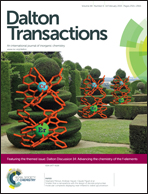The effect of a paramagnetic metal ion within a molecule: comparison of the structurally identical paramagnetic [3,3-Fe(1,2-C2B9H11)2]− with the diamagnetic [3,3-Co(1,2-C2B9H11)2]− sandwich complexes†
Abstract
Derivatives of the ferrabisdicarbollide [3,3′-Fe(1,2-C2B9H11)2]− have been produced starting from the zwitterion [3,3′-Fe(8-(OCH2CH2)2-1,2-C2B9H10)(1′,2′-C2B9H11)], 1, upon reaction with nucleophiles: alkoxides, halides and hydrosulfide ions HS−. The result has been the preparation of [3,3′-Fe(8-(OCH2CH2)2R/X-1,2-C2B9H10)(1′,2′-C2B9H11)] (R = OMe, [2]−; OEt, [3]−; OCH2CH2OCH3, [4]−; and X = Cl, [5]−; Br, [6]−; I, [7]−; and SH, [8]−). The reaction behavior of 1 is comparable to the well-studied cobalt equivalent, [3,3′-Co(8-(OCH2CH2)2-1,2-C2B9H10)(1′,2′-C2B9H11)], and the yields and stability of the resulting complexes are similar. These results are relevant taking into account that [3,3′-Fe(1,2-C2B9H11)2]− is a paramagnetic anion. Implications of this are observed in the 11B-, 1H and 13C NMR spectra of [3,3′-Co(1,2-C2B9H11)2]− and [3,3′-Fe(1,2-C2B9H11)2]− that having identical sandwich molecular structures and the same negative charge have absolutely different widths of the NMR field, between 15 and −25 ppm for [3,3′-Co(1,2-C2B9H11)2]− and in the range 150 to −550 ppm for [3,3′-Fe(1,2-C2B9H11)2]−. The sharpness of both spectra is on the other hand comparable, although no B–H couplings are observed in the Fe metallacarborane or its derivatives. Remarkable is the comparative influence vs. [3,3′-Co(1,2-C2B9H11)2]− of replacing Co by Fe on the elements of the cluster layer nearest to the metal. The two equivalent C cluster (Cc) atoms are influenced at 36 840 Hz, the two equivalent B atoms that are adjacent to the two Cc are influenced at 38 157 Hz and the single B that is adjacent to the two B atoms is influenced at 44 062 Hz. Remarkable is the similar influence on B and on C, taking into account that the values have been obtained from two distinct NMR spectra of 11B and 13C. The {11B–11B} COSY NMR and {1H–11B} HETEROCOSY NMR spectra of [3,3′-Fe(1,2-C2B9H11)2]− have been obtained and are reported for the first time.
![Graphical abstract: The effect of a paramagnetic metal ion within a molecule: comparison of the structurally identical paramagnetic [3,3-Fe(1,2-C2B9H11)2]− with the diamagnetic [3,3-Co(1,2-C2B9H11)2]− sandwich complexes](/en/Image/Get?imageInfo.ImageType=GA&imageInfo.ImageIdentifier.ManuscriptID=C4DT03418J&imageInfo.ImageIdentifier.Year=2015)
- This article is part of the themed collection: In memory of Professor Kenneth Wade

 Please wait while we load your content...
Please wait while we load your content...